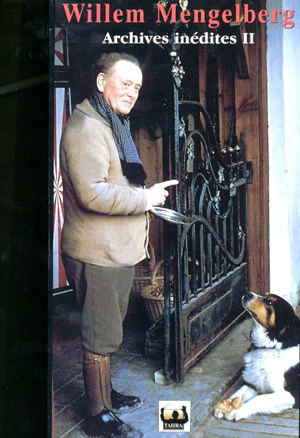The Mengelberg collector has probably never had it
so good. A continuous array of broadcast material seems to pour forth
– and is frequently bewilderingly recycled – from a number of record
companies. What might seem like a first ever release to the laughable
novice turns out to have been released and had a shelf life many times
over. As one who finds the discographic Mengelbergian thickets tough
to penetrate I won’t venture too far off the path but will start by
saying that this is the second volume Tahra has put out devoted to previously
unissued Mengelberg performances – the first was 391/3, a three CD set.
This second volume collates two aspects of the canonical Mengelberg
– his Beethoven and his promotion of contemporary music, a less appreciated
facet of his overwhelming contribution to Dutch musical life.
His Egmont overture from the Salzburg festival in 1942
is dramatically laced and powerful and is in really first class sound,
as is Euryanthe, which was recorded at the same festival but three days
earlier. This, if anything, is even finer – evocative and outsize and
truly dramatic. The First Symphony (Concertgebouw October 1940) features
outer movements of remarkable breadth. All the Mengelberg stamps are
there: huge personality, orchestral mastery, tonal effulgence and some
characteristically outlandish rubati. It is as performances go the polar
extreme of Weingartner’s commercial recording. It’s a great shame that
the Eroica of April 1940 is missing its opening movement. Given
the existence of other Beethoven performances this is low on the list
of priorities but there is still enormous instruction in Mengelberg’s
Marche funebre, very slow and italicised, and the dramatic diminuendi
of the Scherzo with his equally slow trio. The Mozart from March 1942
is in somewhat less good sound and there are some acetate scuffs.
Max Trapp (1887-1971) studied piano with von Dohnányi
and composition with Paul Juon subsequently teaching at the Berlin Hochschule
für Musik. He also took composition master classes in 1934-35.
His Piano Concerto, composed in 1931 and finding an admirer in Walter
Gieseking, is in three movements and lasts some twenty-seven minutes.
It’s the earliest known surviving Mengelberg broadcast performance.
It opens with some cascading leaps, negotiated with a certain drive
by Gieseking. The orchestration is not quite turgid but it does lack
distinction even though the counterpoint is characteristically fluent.
It develops a certain craggy polyphonic drive – Reger’s influence on
Trapp was decisive in this respect it seems – but fails to develop any
neo-classicist potential. The second movement pursues a questing, unsettled
line and features an absorbed clarinet line but once more there’s precious
little to detain one – beyond the archival interest inherent in its
survival. A small chunk of this movement is missing (I believe it’s
intact on a rival Audiophile Classics release). By the time the finale
comes around the piano is in complete control and leads a boisterous
charge; a nice, elfin violin solo also flecks the score (which increasingly
lightens, shedding the Regerian as it does so) and punchy trumpets bring
the work to an assertive conclusion. Of course it’s important to have
this survivor from the mid-thirties but I won’t be returning to it often.
Not so the Voormolen. Born in 1895 and strongly influenced
by French impressionism his Concerto for two oboes is a delight, a real
charmer. The opening is bright, busy, and gently neo-classical and the
second movement, an Arioso, has charm and overlapping traceries. Both
Jaap and Hakon Stotyjn play magnificently – Jaap, the principal oboist
of the Concertgebouw was one of the very few players incidentally that
the increasingly crabby Léon Goossens had any time for. Both
brothers phrase the Arioso with ineffable delicacy and bring to the
finale a chattering and chundering brio, with its muted trumpet full
of humour, which threatens at any moment to turn the august orchestra
into one big dance band turn. Delightful. Brilliantly played as well.
To round things off there is a very spontaneous sounding
1938 interview, made in Munich and lasting five minutes. The text is
reprinted in the documentation to these two CDs which consists of a
long, tall book sized shape, 10" x 5." The colour photographs
of Mengelberg’s chalet retreat are delightful and the commercial discography
and photos of LPs a splendid touch (though in my eagerness to scrutinise
all this my reviewer’s fingers have managed to detach the booklet from
the covers – watch out). A difficult set to review because of the torso
of the Eroica and the miscellaneous nature of the recordings
generally – but I was greatly taken by performances, works and the unusual
presentation of the set and give it a firm and enthusiastic recommendation.
Jonathan Woolf
